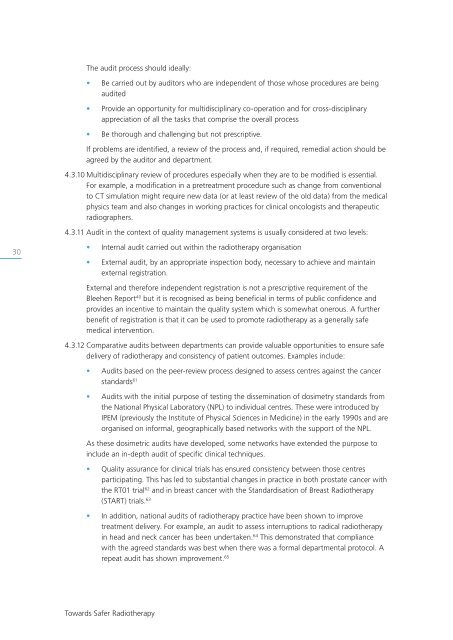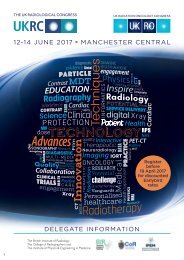Towards Safer Radiotherapy
Towards Safer Radiotherapy
Towards Safer Radiotherapy
You also want an ePaper? Increase the reach of your titles
YUMPU automatically turns print PDFs into web optimized ePapers that Google loves.
The audit process should ideally:<br />
• Be carried out by auditors who are independent of those whose procedures are being<br />
audited<br />
• Provide an opportunity for multidisciplinary co-operation and for cross-disciplinary<br />
appreciation of all the tasks that comprise the overall process<br />
• Be thorough and challenging but not prescriptive.<br />
If problems are identified, a review of the process and, if required, remedial action should be<br />
agreed by the auditor and department.<br />
4.3.10 Multidisciplinary review of procedures especially when they are to be modified is essential.<br />
For example, a modification in a pretreatment procedure such as change from conventional<br />
to CT simulation might require new data (or at least review of the old data) from the medical<br />
physics team and also changes in working practices for clinical oncologists and therapeutic<br />
radiographers.<br />
4.3.11 Audit in the context of quality management systems is usually considered at two levels:<br />
30<br />
• Internal audit carried out within the radiotherapy organisation<br />
• External audit, by an appropriate inspection body, necessary to achieve and maintain<br />
external registration.<br />
External and therefore independent registration is not a prescriptive requirement of the<br />
Bleehen Report 40 but it is recognised as being beneficial in terms of public confidence and<br />
provides an incentive to maintain the quality system which is somewhat onerous. A further<br />
benefit of registration is that it can be used to promote radiotherapy as a generally safe<br />
medical intervention.<br />
4.3.12 Comparative audits between departments can provide valuable opportunities to ensure safe<br />
delivery of radiotherapy and consistency of patient outcomes. Examples include:<br />
• Audits based on the peer-review process designed to assess centres against the cancer<br />
standards 61<br />
• Audits with the initial purpose of testing the dissemination of dosimetry standards from<br />
the National Physical Laboratory (NPL) to individual centres. These were introduced by<br />
IPEM (previously the Institute of Physical Sciences in Medicine) in the early 1990s and are<br />
organised on informal, geographically based networks with the support of the NPL.<br />
As these dosimetric audits have developed, some networks have extended the purpose to<br />
include an in-depth audit of specific clinical techniques.<br />
• Quality assurance for clinical trials has ensured consistency between those centres<br />
participating. This has led to substantial changes in practice in both prostate cancer with<br />
the RT01 trial 62 and in breast cancer with the Standardisation of Breast <strong>Radiotherapy</strong><br />
(START) trials. 63<br />
• In addition, national audits of radiotherapy practice have been shown to improve<br />
treatment delivery. For example, an audit to assess interruptions to radical radiotherapy<br />
in head and neck cancer has been undertaken. 64 This demonstrated that compliance<br />
with the agreed standards was best when there was a formal departmental protocol. A<br />
repeat audit has shown improvement. 65<br />
<strong>Towards</strong> <strong>Safer</strong> <strong>Radiotherapy</strong>



